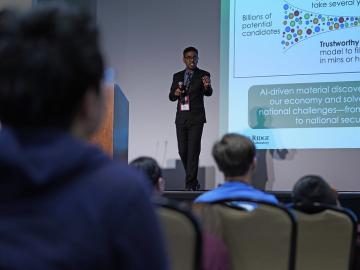
Filter News
Area of Research
- Advanced Manufacturing (2)
- Biological Systems (1)
- Biology and Environment (52)
- Biology and Soft Matter (1)
- Clean Energy (41)
- Computational Biology (1)
- Computational Engineering (1)
- Computer Science (4)
- Fusion and Fission (4)
- Isotopes (4)
- Materials (50)
- Materials for Computing (7)
- National Security (32)
- Neutron Science (25)
- Nuclear Science and Technology (1)
- Quantum information Science (5)
- Supercomputing (90)
News Type
News Topics
- (-) Artificial Intelligence (78)
- (-) Biomedical (46)
- (-) Biotechnology (18)
- (-) Chemical Sciences (53)
- (-) Clean Water (16)
- (-) Cybersecurity (31)
- (-) Machine Learning (35)
- (-) Quantum Science (56)
- (-) Summit (51)
- 3-D Printing/Advanced Manufacturing (84)
- Advanced Reactors (18)
- Big Data (33)
- Bioenergy (74)
- Biology (81)
- Buildings (31)
- Climate Change (72)
- Composites (17)
- Computer Science (143)
- Coronavirus (34)
- Critical Materials (14)
- Decarbonization (64)
- Education (4)
- Element Discovery (1)
- Emergency (2)
- Energy Storage (70)
- Environment (139)
- Exascale Computing (35)
- Fossil Energy (5)
- Frontier (39)
- Fusion (44)
- Grid (40)
- High-Performance Computing (72)
- Hydropower (5)
- Isotopes (45)
- ITER (4)
- Materials (100)
- Materials Science (94)
- Mathematics (7)
- Mercury (9)
- Microelectronics (3)
- Microscopy (36)
- Molten Salt (3)
- Nanotechnology (42)
- National Security (57)
- Net Zero (11)
- Neutron Science (96)
- Nuclear Energy (81)
- Partnerships (45)
- Physics (53)
- Polymers (20)
- Quantum Computing (30)
- Renewable Energy (2)
- Security (22)
- Simulation (40)
- Software (1)
- Space Exploration (15)
- Statistics (2)
- Sustainable Energy (77)
- Transformational Challenge Reactor (7)
- Transportation (52)
Media Contacts

A team of federal contractor and national laboratory engineers and scientists from the U.S. Department of Energy Office of Environmental Management has been nationally distinguished as “Heroes of Chemistry” for making the world better through their effort, ingenuity, creativity and perseverance.

Two ORNL teams recently completed Cohort 18 of Energy I-Corps, an immersive two-month training program where the scientists define their technology’s value propositions, conduct stakeholder discovery interviews and develop viable market pathways.

Researchers at the Department of Energy’s Oak Ridge National Laboratory and partner institutions have launched a project to develop an innovative suite of tools that will employ machine learning algorithms for more effective cybersecurity analysis of the U.S. power grid.

Brian Sanders is focused on impactful, multidisciplinary science at Oak Ridge National Laboratory, developing solutions for everything from improved imaging of plant-microbe interactions that influence ecosystem health to advancing new treatments for cancer and viral infections.
The contract will be awarded to develop the newest high-performance computing system at the Oak Ridge Leadership Computing Facility.

To better predict long-term flooding risk, scientists at the Department of Energy’s Oak Ridge National Laboratory developed a 3D modeling framework that captures the complex dynamics of water as it flows across the landscape. The framework seeks to provide valuable insights into which communities are most vulnerable as the climate changes, and was developed for a project that’s assessing climate risk and mitigation pathways for an urban area along the Southeast Texas coast.

ORNL's Guang Yang and Andrew Westover have been selected to join the first cohort of DOE’s Advanced Research Projects Agency-Energy Inspiring Generations of New Innovators to Impact Technologies in Energy 2024 program. The program supports early career scientists and engineers in their work to convert disruptive ideas into impactful energy technologies.

Researchers used quantum simulations to obtain new insights into the nature of neutrinos — the mysterious subatomic particles that abound throughout the universe — and their role in the deaths of massive stars.
Close on the heels of its fourth summer school, the Quantum Science Center, or QSC, hosted its second in-person all-hands meeting in early May. More than 150 scientists, engineers and support staff traveled from 17 institutions to review the QSC’s progress, examine existing priorities and brainstorm new short- and long-term research endeavors.

Prasanna Balaprakash, a national leader in artificial intelligence, or AI, spoke to some of the highest achieving students in the country at the National Science Bowl in Washington D.C.


